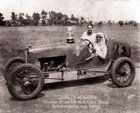
For Gold and Glory 2003
Distributed by Cinema Guild, 115 West 30th Street, Suite 800, New York, NY 10001; 212-685-6242
Produced by Todd Gould
Directed by Todd Gould
VHS, color, 56 min.
Jr. High - Adult
African American Studies, Political Science, Sports, Sociology
Date Entered: 03/31/2005
Reviewed by Thomas J. Beck, Auraria Library, University of Colorado at DenverMany of us think of the decade following World War I as the “Roaring Twenties”, a carefree time of flappers, jazz music and bathtub gin. It was also a time when auto racing reached theretofore unseen levels of popularity, becoming almost a national craze. For all of the seeming lightheartedness of the decade however, it had a much darker side that is not always apparent in the history books. The Ku Klux Klan achieved unparalleled levels of popularity and political influence at that time, and used their clout to help reinforce a strict grid of racial segregation that then existed in America. In the midst of this oppressive atmosphere, an African-American auto mechanic named Charlie Wiggins decided to defy the racist presumptions of his time and become a professional race driver. Participation in racing was then closed to blacks. Charlie continued to pursue his goal nevertheless, and in the process helped to establish an “Indy 500” for the African-American community, the “Gold & Glory Sweepstakes”. This race would make him a star, and leave him with the moniker “The Negro Speed King”. This documentary film tells his story and that of the race he came to symbolize.
Blacks were denied an opportunity to drive or otherwise participate in races at mainstream (e.g. white) venues, because of the racist myth popular at the time, that they lacked both the courage, and physical and technical skill to compete successfully. By pursuing his dream of becoming a race driver, Charlie hoped not only to reach his personal goal, but to challenge and defeat this myth that so dehumanized him and his people. To this end, he applied repeatedly to compete in the Indianapolis 500. The white promoters of that event turned him down time after time, in keeping with the racist tenor of the times. This was despite the fact that he was well known as a talented driver and auto mechanic, even by white drivers, many of whom were his friends. Charlie was undeterred by this rejection however, and continued to apply, and be turned down, throughout his racing career. It was because of this and other like rejections, that he came to participate in the “Gold and Glory Sweepstakes”,
Certain African-American businessmen in Indianapolis became aware of Charlie’s driving talents and those of other black drivers, and decided to showcase them in races designed for African-Americans. These would not only be entertaining, but a source of pride to the whole of the black community. They founded the “Colored Speedway Association”, for this purpose. The “Gold and Glory Sweepstakes” was to be the largest and most prestigious of the races they promoted. The first one was held in 1924, and not surprisingly Charlie was the winner. Over the next 6 years he won the championship 3 times, and would finish in the top 5 for the next 10 years. He became the biggest star in the black racing circuit. While this made Charlie famous, it also made him a target for white racists. Being an African-American celebrity was enough to inflame such individuals, but Charlie was especially hated for defying the segregationist practices of his time, chiefly though his repeated attempts to compete in the Indy 500 and other white racing venues. As a consequence his property was repeatedly vandalized, and he was physically attacked on more than one occasion. Although Charlie was a small man (he only weighed about 100 pounds), he had a fiery and determined disposition, and successfully fought off his attackers again and again, even when they outnumbered him 2 or 3 to 1! He continued to persevere, and kept on winning race after race, despite these attacks and a number of tragedies in his personal life. In the process he not only became a sports hero, but a black hero. A man who came to symbolize the strength, dignity and talent of his people.
Charlie continued to compete through the 20’s and well into the 30’s. He also became a mentor to any number of aspiring young race drivers and auto mechanics, both black and white, who often congregated at his Indianapolis garage. This is a roll he would play, and play gladly, until his death in 1979. These young men were often referred to as “Charlie’s Gang”, and included some individuals who would become quite famous, such as Bill Cummings, the winner of the 1934 Indianapolis 500.
Charlie stopped racing in the late 30’s, and because of years of ill health that followed and the attendant medical bills, was almost penniless when he died some 30 years later. Yet in spite all of the hardship and tragedy in his life, he became a legend in the racing community and a source of hope and dignity to the African-Americans of his time.
This film is narrated by the late Ossie Davis, who’s deep, authoritative voice leads the viewer through this story in a gentle and reassuring way, though the story itself can often be disturbing, and at times even shocking. His wife, Ruby Dee, does an equally effective job reading the letters of Charlie’s wife, Roberta, which are heard in voiceover at different points throughout the production. Photographs, film clips and newspaper headlines from the period fill the rest of the film, along with interviews with historians and Charlie’s contemporaries, who describe his life and legacy. The picture and sound qualities of this film are good, and the production as a whole is one that engages and informs the viewer.